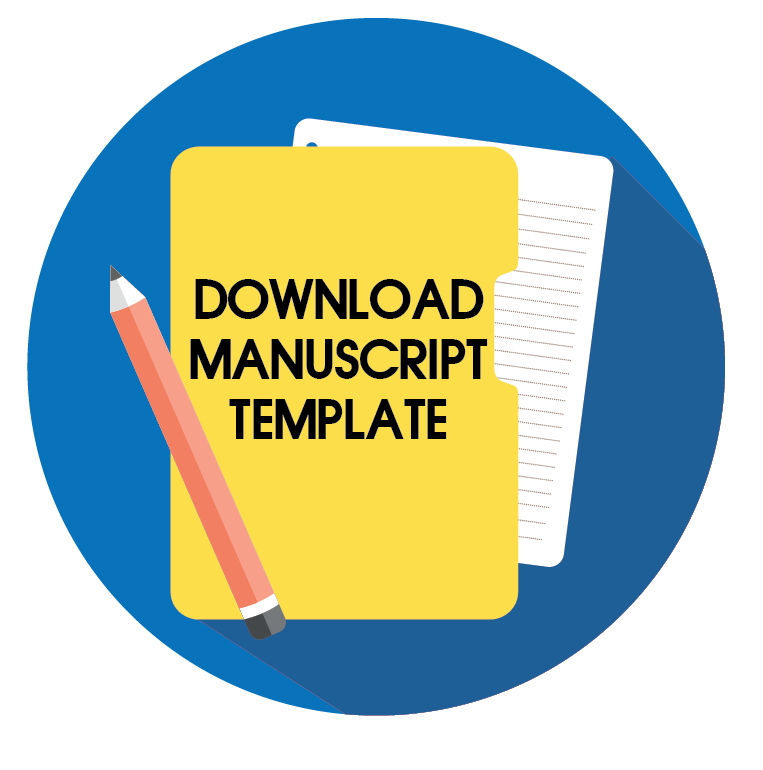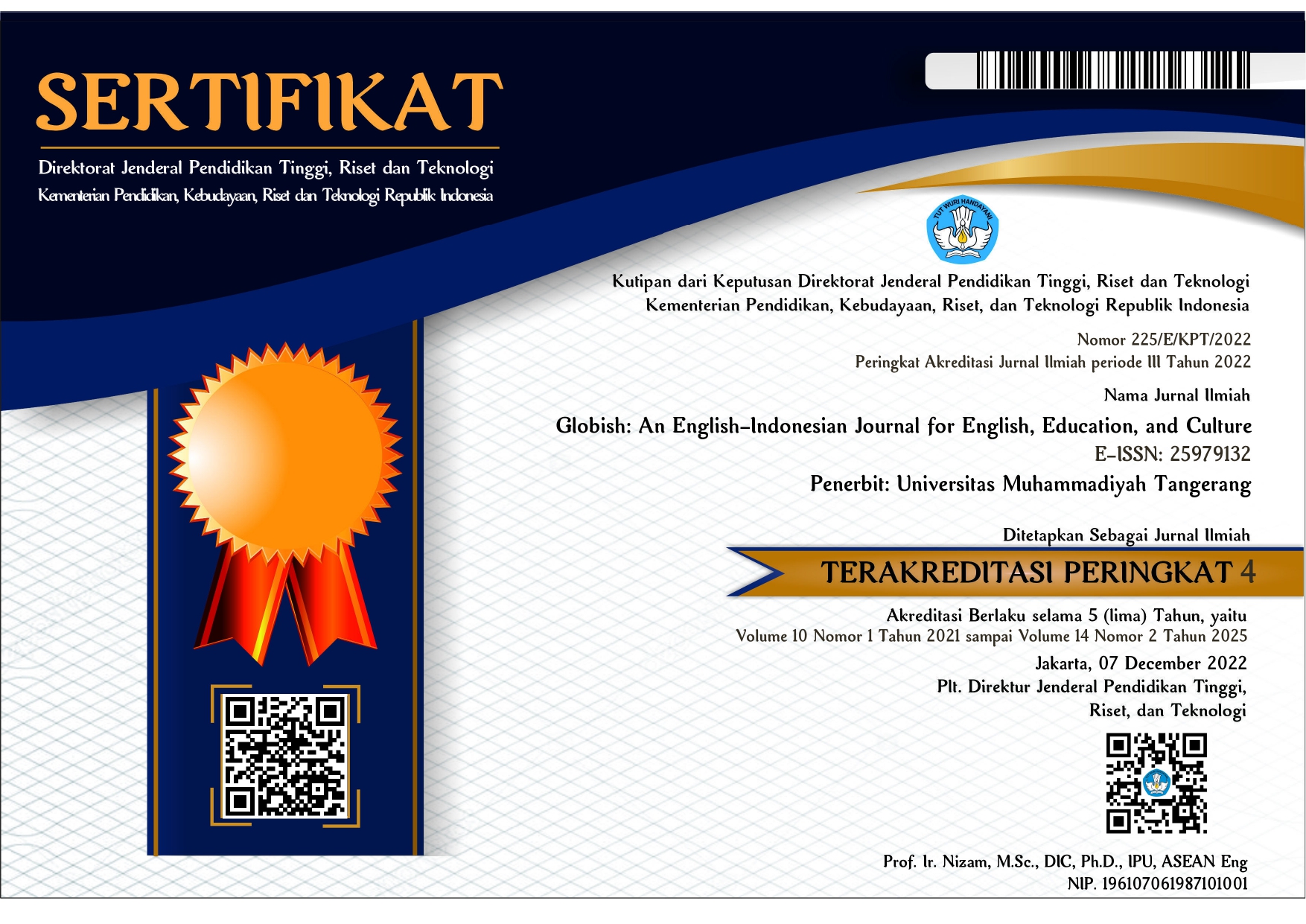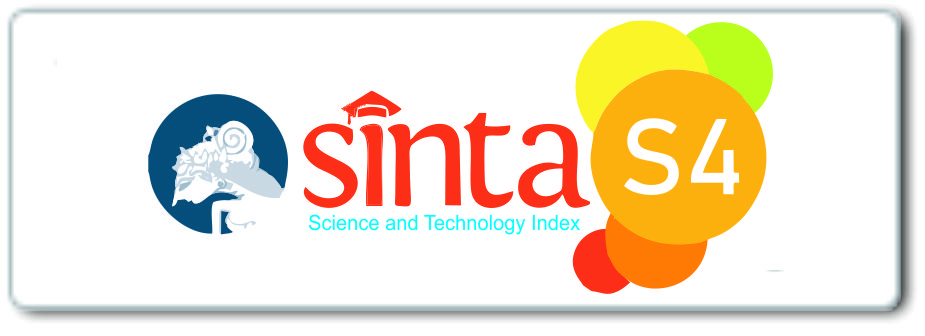THE EFFECT OF USING FLIPPED LEARNING STRATEGY IN IMPROVING STUDENTS’ SPEAKING SKILL IN HYBRID LEARNING
Abstract
The purpose of the study was to determine the the effect of the Flipped Classroom method application on students' speaking skill in hybrid learning. The term "flipped classroom" describes a teaching method in which teachers have students complete their assignments during class time while doing the usual lecture at home. The study was conducted at a vocational high school in Surabaya. There were 18 students who were majoring Online Business And Marketing class involved as the participant. Experimental research with the pre-experimental method was used in this research. The research design of the study is a one-group pretest-posttest. The obtained data was analyzed using T-test and presented as quantitative data by the researcher. The findings of this study indicate that the ttest = 8.416 and ttable = 1.740 ( ttest > ttable) while the significance value of 0.000 < 0.05, the H0 is declined whereas the H1 is approved. In conclusion, the Flipped Classroom is effective in enhancing vocational high school students’ speaking skills.
Keywords
Full Text:
PDFReferences
Abdelshaheed, B. S. M. (2017). Using Flipped Learning Model in Teaching English Language among Female English Majors in Majmaah University. English Language Teaching, 10(11), 96. https://doi.org/10.5539/elt.v10n11p96
Ahmad, S. (2016). The Flipped Classroom Model to Develop Egyptian EFL Students’ Listening Comprehension. English Language Teaching, 9(9), 166. https://doi.org/10.5539/elt.v9n9p166
Al-Zahrani, A. M. (2015). From passive to active: The impact of the flipped classroom through social learning platforms on higher education students’ creative thinking. British Journal of Educational Technology, 46(6), 1133–1148. https://doi.org/10.1111/BJET.12353
Allen, I. E., Seamen, J., & Garrett, R. (2007). Blending in: The extent and promise of blended education in the United States. USA: The Sloan Consortium. Blending in: The Extent and Promise of Blended Education in the United States. USA: The Sloan Consortium., May 2014, 1–29.
Almahasees, Z., Papadopoulos, G. A., Hamouda, S., Mohsen, K., & Amin, M. O. (2021). Faculty’s and Students’ Perceptions of Online Learning During COVID-19. https://doi.org/10.3389/feduc.2021.638470
Arnold-Garza, S. (2014). The Flipped Classroom Teaching Model and Its Use The Flipped Classroom Teaching Model and Its Use for Information Literacy Instruction for Information Literacy Instruction. Communications in Information Literacy, 8(1), 7–22. https://doi.org/10.15760/comminfolit.2014.8.1.161
Bahri, A. (2018). Beyond effective teaching: Enhancing students’ metacognitive skill through guided inquiry. 954, 12022. https://doi.org/10.1088/1742-6596/954/1/012022
Basal, A. (2015). THE IMPLEMENTATION OF A FLIPPED CLASSROOM IN FOREIGN LANGUAGE TEACHING. Turkish Online Journal of Distance Education.
Bell, J., Sawaya, S., & Cain, W. (2014). Synchromodal Classes: Designing for Shared Learning Experiences Between Face-to-Face and Online Students. International Journal of Designs for Learning, 5(1). https://doi.org/10.14434/IJDL.V5I1.12657
Bergmann, J., & Sams, A. (2012). Flip Your Classroom: Reach Every Student in Every Class Every Day. International Society for Technology in Education. www.iste.org/learn/publications/permissions-and-
Bozkurt, A., Akgun-Ozbek, E., Yilmazel, S., Erdogdu, E., Ucar, H., Guler, E., Sezgin, S., Karadeniz, A., Sen-Ersoy, N., Goksel-Canbek, N., Dincer, G. D., Ari, S., & Aydin, C. H. (2015). Trends in distance education research: A content analysis of journals 2009-2013. International Review of Research in Open and Distance Learning, 16(1), 330–363. https://doi.org/10.19173/IRRODL.V16I1.1953
Brown, H. D., & Frazier, S. (2001). Teaching by Principles: An Interactive Approach to Language Pedagogy. TESOL Quarterly, 35(2), 341. https://doi.org/10.2307/3587655
Cohen, L., Manion, L., & Morrison, K. (2017). Research Methods in Education. In Research Methods in Education. Routledge. https://doi.org/10.4324/9781315456539/RESEARCH-METHODS-EDUCATION-LOUIS-COHEN-LAWRENCE-MANION-KEITH-MORRISON
Ekmekci, E. (2017). The flipped writing classroom in Turkish EFL context: A comparative study on a new model. Turkish Online Journal of Distance Education, 18(2), 151–167. https://doi.org/10.17718/TOJDE.306566
Eldeen, H., & El-Sawy, A. (2018). Flipping EFL University Classes with Blackboard System. English Language Teaching, 11(2), p31. https://doi.org/10.5539/ELT.V11N2P31
Enfield, J. (2013). Looking at the Impact of the Flipped Classroom Model of Instruction on Undergraduate Multimedia Students at CSUN. TechTrends 2013 57:6, 57(6), 14–27. https://doi.org/10.1007/S11528-013-0698-1
Esani, M. (2010). Moving from face-to-face to online teaching. Clinical Laboratory Science : Journal of the American Society for Medical Technology, 23(3), 187–190. https://doi.org/10.29074/ASCLS.23.3.187
Ferdig, R., Cavanaugh, C., & Freidhoff, J. (2012). Lessons Learned from Blended Programs: Experiences and Recommendations from the Field. Vienna, VA: INACOL. https://aurora-institute.org/resource/lessons-learned-from-blended-programs-experiences-and-recommendations-from-the-field/
Gleason, B., & Greenhow, C. (2017). Hybrid learning in higher education: The potential of teaching and learning with robot-mediated communication. Online Learning Journal, 21(4), 159–176. https://doi.org/10.24059/OLJ.V21I4.1276
Hannula, J. (2019). Characteristics of teacher knowledge produced by pre-service mathematics teachers: The case of open-ended problem-based learning. LUMAT, 7(3), 55–83. https://doi.org/10.31129/LUMAT.7.3.391
Harahap, F., & Manurung, B. (2019). The Effect of Blended Learning on Student’s Learning Achievement and Science Process Skills in Plant Tissue Culture Course. International Journal of Instruction, 12(1), 521–538. www.e-iji.net
Harmer, J. (2009). How to Teach English. In HOW TO TEACH ENGLISH (Fourth). Pearson Education Limited.
Hashemifardnia, A., Shafiee, S., Rahimi Esfahani, F., & Sepehri, M. (2021). Effects of flipped instruction on iranian intermediate EFL learners’ speaking complexity, accuracy, and fluency. Cogent Education, 8(1). https://doi.org/10.1080/2331186X.2021.1987375
Kurniawan, A. (2018). Metodologi Penelitian Pendidikan . Bandung: Remaja Rosdakarya. http://repository.syekhnurjati.ac.id/3334/
Linder, K. E. (2017). Fundamentals of Hybrid Teaching and Learning. New Directions for Teaching and Learning, 2017(149), 11–18. https://doi.org/10.1002/TL.20222
M A Tabataba I, S. I., hD, P., & Tabatabai, S. (2019). Commentary COVID-19 impact and virtual medical education. J Adv Med Educ Prof, 8(3). https://doi.org/10.30476/jamp.2020.86070.1213
MacIntyre, P. D. (2007). Willingness to Communicate in the Second Language: Understanding the Decision to Speak as a Volitional Process. The Modern Language Journal, 91(4), 564–576. https://doi.org/10.1111/J.1540-4781.2007.00623.X
Mackey, A., & Gass, S. M. (2015). Second language research: Methodology and design, second edition. Second Language Research: Methodology and Design, Second Edition, 1–434. https://doi.org/10.4324/9781315750606/SECOND-LANGUAGE-RESEARCH-ALISON-MACKEY-SUSAN-GASS
Mclean, S., Attardi, S. M., Faden, L., & Goldszmidt, M. (2016). Flipped classrooms and student learning: not just surface gains. Adv Physiol Educ, 40, 47–55. https://doi.org/10.1152/advan.00098.2015.-The
Muklas, M. (2017). TALKING CHIPS TECHNIQUE TO TEACH SPEAKING. Journal of English Language Education and Literature, II(1).
Namaziandost, E., Hashemifardnia, A., Shafiee, S., & Feng, G. C. (2018). The impact of opinion-gap, reasoning-gap, and information-gap tasks on EFL learners’ speaking fluency Ehsan Namaziandost, Arash Hashemifardnia & Sajad Shafiee | The impact of opinion-gap, reasoning-gap, and information-gap tasks on EFL learners’ speaking fluency PUBLIC INTEREST STATEMENT. Cogent Social Sciences, 26, 1630150. https://doi.org/10.1080/23311886.2019.1630150
O’Byrne, W. I., & Pytash, K. E. (2015). Hybrid and Blended Learning: Modifying Pedagogy Across Path, Pace, Time, and Place. Journal of Adolescent and Adult Literacy, 59(2), 137–140. https://doi.org/10.1002/JAAL.463
Ozdamli, F., & Asiksoy, G. (2016). Flipped Classroom Approach. World Journal on Educational Technology: Current Issues, 8(2), 98–105. https://doi.org/10.18844/wjet.v8i2.640
Purnomo, E., & Suhendra, E. S. (2020). Analisis masa kerja dan promosi terhadap kinerja karyawan BPJS Ketenagakerjaan. JURNAL NUSANTARA APLIKASI MANAJEMEN BISNIS, 5(1), 32–43. https://doi.org/10.29407/NUSAMBA.V5I1.13801
Rababah, G. (2005). Communication Problems Facing Arab Learners of English Etisalat Academy. Journal of Language and Learning, 3(1).
Richards, J. C. (2008). Teaching Listening and Speaking From Theory to Practice (Vol. 35). Cambridge: Cambridge University Press. www.cambridge.org
Saichaie, K. (2020). Blended, Flipped, and Hybrid Learning: Definitions, Developments, and Directions. New Directions for Teaching and Learning, 2020(164), 95–104. https://doi.org/10.1002/TL.20428
Scott, T. (2005). How To Teach Speaking. Longman.
Simamora, R. M. (2020). The Challenges of Online Learning during the COVID-19 Pandemic: An Essay Analysis of Performing Arts Education Students. Studies in Learning and Teaching, 1(2), 86–103. https://doi.org/10.46627/SILET.V1I2.38
Slomanson, W. R. (2014). Blended Learning: A Flipped Classroom Experiment. Journal of Legal Education, 64. https://heinonline.org/HOL/Page?handle=hein.journals/jled64&id=97&div=&collection=
Smith, G. G., & Taveras, M. (2005). The missing instructor. ELearn, 2005(1), 1. https://doi.org/10.1145/1070931.1070933
Staker, H., & Horn, M. B. (2012). Classifying K-12 Blended learning.
Stone, B. B. (2012). Flip Your Classroom to Increase Active Learning and Student Engagement. http://www.biology.missouri.edu/courses/bio1010/life_organized.swf
Sudarmaji, I., Amaliyah Anwar, A. A., & Mulyana, A. (2021). Developing Students’ Speaking Skills through Flipped Classroom Model. Journal of English Education and Teaching, 5(2), 188–200. https://doi.org/10.33369/jeet.5.2.188-200
Syafiq, A. N., Rahmawati, A., Anwari, A., & Oktaviana, T. (2021). Increasing Speaking Skill through YouTube Video as English Learning Material during Online Learning in Pandemic Covid-19. Elsya : Journal of English Language Studies, 3(1), 50–55. https://doi.org/10.31849/ELSYA.V3I1.6206
Teng, M. F. (2017). Flipping the classroom and tertiary level EFL students’ academic performance and satisfaction. Journal of Asia TEFL, 14(4), 605–620. https://doi.org/10.18823/ASIATEFL.2017.14.4.2.605
Willis, J. (1996). A framework for task-based learning. Longman.
Wu, W. C. V., Hsieh, J. S. C., & Yang, J. C. (2017). Creating an online learning community in a flipped classroom to enhance efl learners’ oral proficiency. Educational Technology and Society, 20(2), 142–157.
Yusup, F. (2018). Uji Validitas dan Reliabilitas Instrumen Penelitian Kuantitatif. Tarbiyah : Jurnal Ilmiah Kependidikan, 7(1), 17–23. https://doi.org/10.18592/TARBIYAH.V7I1.2100
Zhang, S. (2009). The Role of Input, Interaction and Output in the Development of Oral Fluency. English Language Teaching, 2(4). https://doi.org/10.5539/ELT.V2N4P91
DOI: http://dx.doi.org/10.31000/globish.v12i1.6652
Article Metrics
Abstract - 2329 PDF - 1019Refbacks
- There are currently no refbacks.
Globish
Program Studi Pendidikan Bahasa Inggris
Fakultas Keguruan dan Ilmu Pendidikan
Universitas Muhammadiyah Tangerang
Jl. Perintis Kemerdekaan I/33, Cikokol
Kota Tangerang, Indonesia
e-mail: globish_journal@umt.ac.id
Globish (p-ISSN: 2301-9913 | e-ISSN: 2301-9913) is licensed under a Creative Commons Attribution-ShareAlike 4.0 International License.









